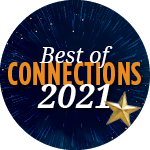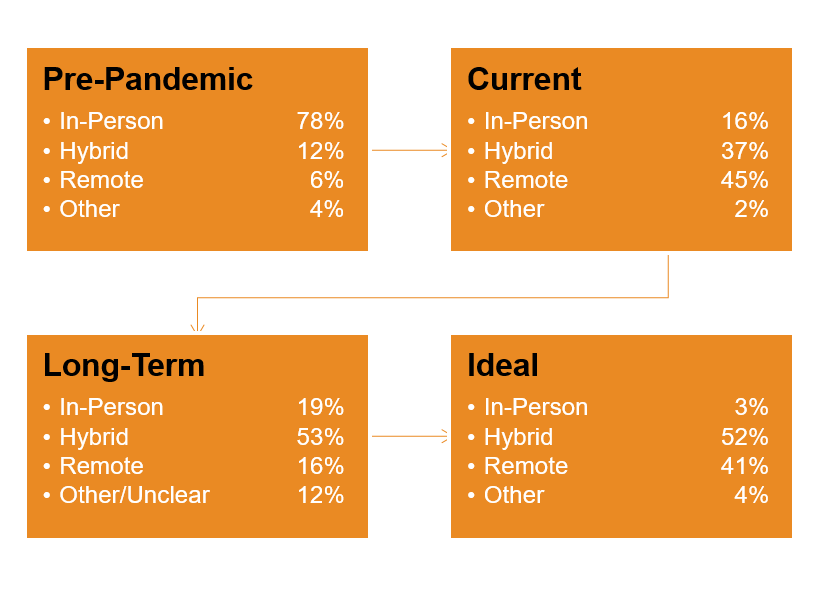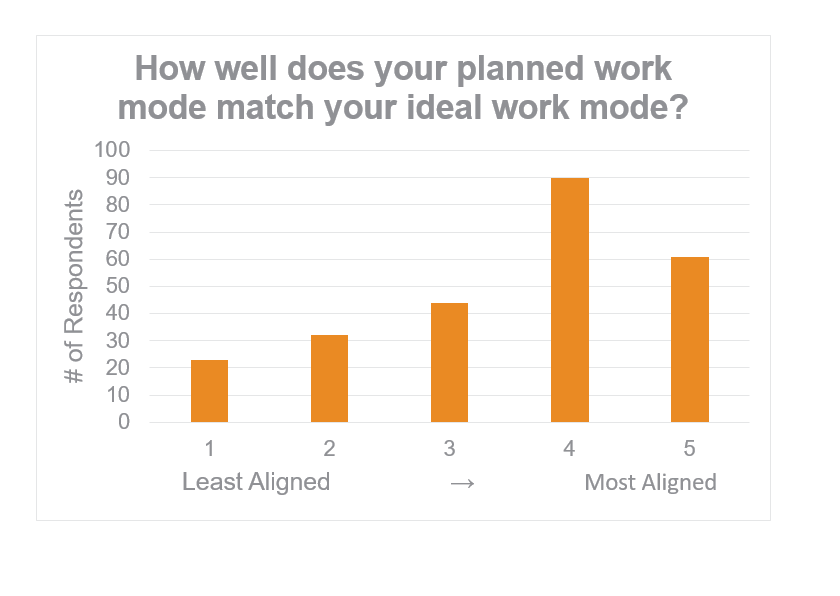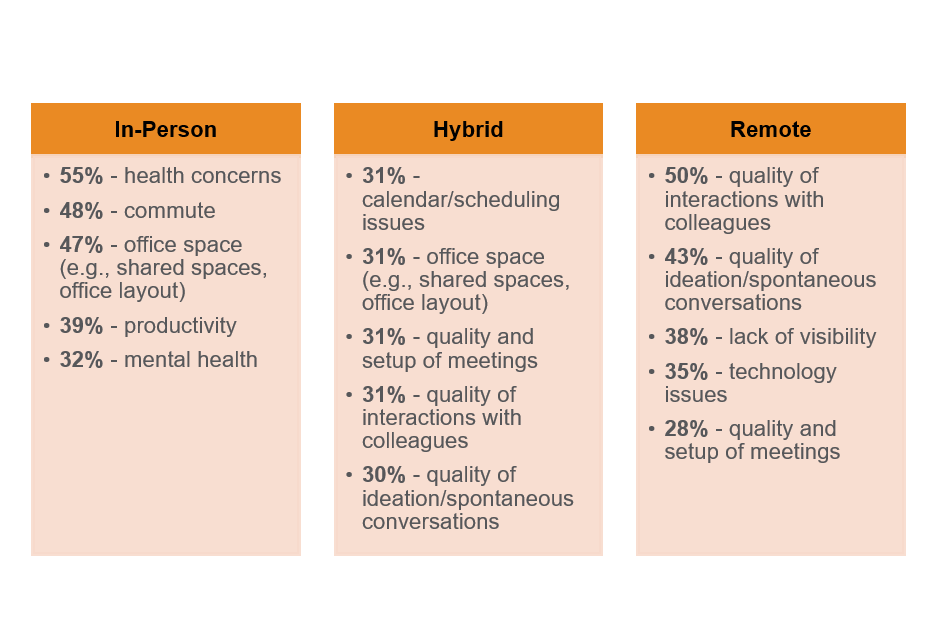Professional Development
Prospect Development’s Post-Pandemic Transition
By Anthony Parrish | November 18, 2021

Editor's Note: This article is featured in Best of Connections 2021. Read Apra Editorial Advisory Committee Chair Jessica Balsam's editor's message to learn more about the top articles of the year.
What does a “normal” workweek look like for you? Did you leave the in-person office in 2020 to never return? Did you never leave the office? Has your leadership made post-pandemic organizational plans clear? Is there a plan?
There are a lot of questions floating around, and Apra’s Editorial Advisory Committee (EAC) wants to help give you some answers — and if not answers, at least some context from your peers.
As many conversations about a post-pandemic workplace are still in progress, we hope to provide some solid data around our profession for you to use in discussions with leaders, when making decisions for your team and to simply understand what your organization looks like compared with others.
With that in mind, the Apra EAC asked prospect development professionals to complete the Apra Connections Post-Pandemic Transition Survey from September 21 to October 7 of this year. And did you ever respond! Two hundred fifty-one (251) individuals contributed to give us a snapshot of our profession.
That group of 251 looks like this:
- Respondents hail from across the United States and Canada
- Regarding sub-areas of prospect development:
- 86% are involved in prospect research
- 64% are involved in relationship/prospect management
- 36% are involved in analytics
- 25% are involved in campaigns
- 37% are managers and 63% are non-managers
- 38% of respondents work on prospect development teams of two or fewer, 31% on teams of three to five, 14% six to nine, and 18% on teams with 10 or more.
- The industry breakdown is:
- 66% higher education
- 11% healthcare
- 5% human services
- 4% arts/culture
- 3% environment
- 11% from a variety of other areas
Key Takeaways
Prospect development professionals have overall followed some of the broader trends of 2020 and 2021. The pandemic did not slow down job transitions, with promotions and opportunities for growth leading the way for change.
As we move towards 2022, many institutions are shifting gears toward hybrid work modes. Productive remote and hybrid work done during 2020 and 2021 has translated into more offerings of hybrid and remote work positions in the long-term. Even with this shift, the demand for remote and hybrid offices is high and greater than what organizations currently are offering.
Uncertainty continues to reign: nearly a third of prospect development professionals do not know when their long-term work mode is going to start; many institutions are still trying to figure out what the standard operating procedures will be. And even for those organizations that have figured out their permanent work plans, it will be a long time until all the concerns of employees are addressed. More than a third of respondents said they were dissatisfied or very dissatisfied with their organization’s decision-making process for long-term work modes.
So, without further ado, here are the survey results:
Job Changes
With national media initially concerned with people leaving the workforce for childcare, healthcare, or other personal reasons — and now trumpeting the “Great Resignation” for workers — how did prospect development fare? Eighteen percent (18%) of survey respondents have changed jobs during the pandemic (defined as February 2020 or later).
- 58% of those experiencing a job change cited either promotion or finding an opportunity for growth at a different employer.
- 17% were impacted by budget cuts (e.g., laid-off).
- 14% were motivated by pandemic-related policies (e.g., left their organization because of its policies, or found policies at another organization more appealing)
- 6% are new to the field or found their first job in prospect development
Work Modes
What does your work mode look like? Is it fully remote, in-person or somewhere in between?
The breakdown below shows the percent of respondents in each category: what prospect development looked like prior to March 2020 (pre-pandemic), what the status is, what it will look like long-term (or at least what is planned) and preferred work mode.

The obvious takeaway: in-person offices are down from 78% to 16%, with 19% expecting to be long-term in-person, and only 3% of respondents consider a fully in-person setting their ideal work mode. Hybrid and remote work modes are currently the norm, accounting for 82% of respondents, and will continue to be prevalent with 69% of respondents planning for that setting long-term.
But aside from the descriptive percentages, looking at the ideal work modes gives a sense of where prospect development, as a profession, could trend. Almost all respondents (93%) want a hybrid or remote position. And the desire for remote work far outpaces the long-term plans of organizations (at least at this point). As seen below, 1 out of 5 respondents say their planned work mode isn’t a good match with their desired work mode. How are organizations, and teams, going to address the discrepancies? Can managers provide flexibility without full institutional shifts away from in-person work?

When Is the Transition?
The other question that is a bit of a Damocles revolves around the timing of any transition. Some organizations are already in their permanent work modes, while others are trying to figure out what that will look like. Here is when your peers said they were moving to a long-term/permanent/post-pandemic work mode:
- 41% are already in long-term work modes
- 29% don’t know when their long-term work mode transition will occur
- 12% were transitioning from September 2021 through November 2021
- 15% are transitioning from December 2021 through February 2022
- 4% are transitioning March 2022 and beyond
Remote and Hybrid Work Requirements
Remote and hybrid work modes often come with conditions. Some are geographically constrained; others are fully location agnostic.
To get a better picture of what hybrid work means in prospect development, we asked hybrid workers how many days per week they are or will be working on-site or in-person.
- 19% have no requirement
- 12% must be on-site 1 day per week
- 33% must be on-site 2 days per week
- 25% must be on site 3 days per week
- 8% must be on-site 4 days per week
- 8% do not know yet
Drilling down further, how remote is remote? To get a better picture of what prospect development remote work looks like, we asked remote workers if they are required to be in-person/on-site at all.
- 29% are fully remote with no on-site requirements
- 4% are required to be on-site 1-2 times per year
- 5% are required to be on-site 3-5 times per year
- 1% are required to be on-site 6-11 times per year
- 24% are required to be on-site 12+ times per year
- 39% don’t know their requirements yet
As evidenced by nearly 4 in 10 remote workers not knowing their in-person/on-site requirements yet, conditions for remote work remain in flux. Many organizations are still working through their policies around remote work, and as such these requirements, and other aspects of remote work, will continue to change. While some prospect development professionals have been remote for a year and a half, it will be a while until new norms around this work mode are established across the industry.
The Top 5 Concerns for Each Work Mode
In thinking about each work mode, there is a natural variation in concerns for employees. For remote workers, the concerns might reflect their distance from colleagues and the logistic realities of a virtual workplace. For hybrid and in-person workers, concerns might be centered around working during a public health crisis or readjusting to the office. Here are the top five concerns for each group:

You can clearly see that certain topics are of more concern depending on the work mode. Health concerns are still incredibly prevalent for those working in-person. Hybrid and remote work modes share some concerns, but managers and team leaders should be careful to not respond to perceived concerns with blanket proposals or policies. Flexibility and high-quality communication are still premium traits for prospect development professionals!
What’s Next
Thank you to everyone who took the time to respond. Hopefully, this provides context for your own experience and lends itself to discussions within your organization around the future of what prospect development work looks like. If you want to see more content like this or have a particular subject, you’d love to see Apra members surveyed about, let us know!
If you have any questions about the data presented here, please reach out to Anthony Parrish at aparrish@stanford.edu.

Anthony Parrish
Assistant Director of Development Research, Stanford University
Anthony Parrish works on the prospect development team at Stanford University as an assistant director of development research. He is a member of the Apra Connections Editorial Advisory Committee and enjoys learning from other prospect development professionals about their best practices, research tools, et cetera. Anthony’s 10+ years with nonprofits have included time in higher education, independent/secondary education, human services, and community arts.